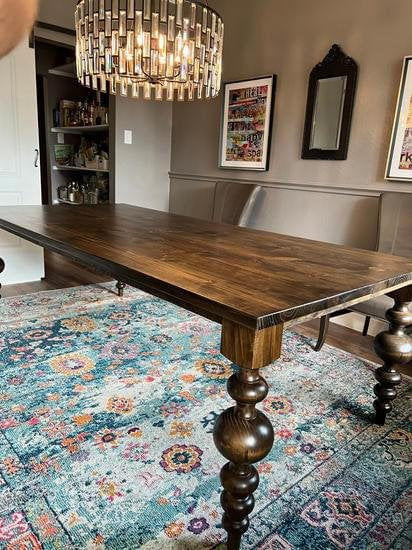From Traditional to Modern: Locate the Perfect Dining Space Table Legs for Your Style
While classic styles such as cabriole and transformed legs evoke a sense of classic elegance, modern designs like hairpin and geometric choices offer a possibility for striking visual rate of interest. As you consider these elements, the question remains: how can you perfectly integrate these diverse leg styles to create an unified dining experience?
Understanding Table Leg Styles
The selection of eating area table leg designs can substantially affect both the aesthetic appeals and capability of the space. Each leg style contributes distinct practical functions and visual aspects, catering to diverse design preferences and use requirements. Comprehending these styles is important for picking the best eating table that aligns with your overall interior decoration vision.
As an example, tapered legs provide a tidy, traditional appearance that can enhance a room's elegance, while stand bases give stability and optimize legroom, making them suitable for smaller spaces. Barrette legs, a characteristic of mid-century modern style, present a commercial panache, enabling a ventilated, open feel. In a similar way, trestle legs evoke rustic appeal, offering robust assistance and a sense of timelessness.
Wooden legs can bring heat and structure, whereas steel choices often communicate a sleek, modern ambiance. Inevitably, understanding table leg designs is crucial for developing a cohesive dining location that shows individual style while making certain usefulness and convenience.
Traditional Table Leg Options
When choosing dining-room table legs, traditional choices typically embody timeless style and workmanship. These designs show an abundant heritage and a dedication to high quality, making them suitable for those who value timeless appearances.
Among one of the most legendary standard leg designs is the cabriole leg, identified by its graceful bent shape. This style typically features attractive carvings and is most typically located in Queen Anne and Chippendale furniture. One more prominent choice is the turned leg, which boasts a series of smooth, rounded forms that give a traditional look while maintaining security.
Additionally, the straight leg, while basic, provides a tough and unadorned structure that can blend effortlessly with a variety of tabletop styles. For those attracted to ornate describing, claw-and-ball feet legs evoke a feeling of magnificence and can work as a sensational focal point in any kind of dining space.
Last but not least, pedestal bases, although not purely legs, provide an alternative typical choice that permits adequate legroom and can be beautifully sculpted. Each of these typical leg designs contributes to the overall ambiance of a dining area, weding function with aesthetic allure.

Modern Table Leg Designs
Modern table leg designs supply a diverse variety of designs that stress tidy lines and cutting-edge materials. These designs often focus on performance while functioning as striking focal points within an eating room. Minimal aesthetics are common, with legs crafted from materials such as metal, glass, and crafted timber, which add to a airy and modern feel.
One preferred design is the hairpin leg, identified by its slender, conical framework that supplies security without overwhelming the tabletop (dining room table legs). This design is often discovered in mid-century contemporary furniture and can effortlessly complement various dining table shapes. One more pattern is making use of geometric forms, where legs may take on angular or asymmetrical forms, adding visual rate of interest and a touch of artistry

Blending Designs for Distinct Areas
Frequently, house owners seek to create one-of-a-kind dining areas Full Article that mirror their personal design by mixing various layout elements. This strategy enables the incorporation of diverse aesthetic appeals, leading to a harmonious yet unique environment. Pairing a rustic wood table with smooth, modern metal legs can develop an eye-catching comparison that raises the room's total charm.
Furthermore, integrating vintage table legs with modern tabletops can evoke a feeling of history while keeping a modern-day perceptiveness. Such mixes not just display specific preference however also urge imagination, allowing house owners to curate an area that really feels both personal and inviting.
Shade plays a critical duty in this mixing procedure; picking table legs that match or comparison with the existing color system can boost visual passion. Whitewashed legs can soften the boldness of a dark table surface area, producing a balanced visual.
Tips for Picking the Right Legs
Selecting the right table legs is crucial for attaining both functionality and aesthetic charm in your dining space. Begin by Homepage considering the general style of your room. Conventional settings take advantage of legs that include elaborate carvings or turned designs, while modern spaces may call for sleek, minimal styles.
Next, evaluate the height and stability of the legs. dining room table legs. Conventional eating tables range between 28 to 30 inches in elevation, so ensure the legs complement this dimension for convenience. Additionally, durable materials, such as wood or steel, can improve security and durability
Assess the leg shape also-- alternatives include right, tapered, or stand designs. Straight legs offer a classic appearance, while conical legs can add a touch of beauty. Pedestal bases provide sufficient legroom and are ideal for smaller sized rooms.
Conclusion
In recap, selecting the ideal dining space table legs requires careful factor to consider of both contemporary and standard styles. By balancing leg design, elevation, and product with the overall decor, a cohesive and inviting atmosphere can be attained.
The selection of dining space table leg styles can significantly affect both the looks and functionality Going Here of the space. Eventually, recognizing table leg designs is essential for producing a natural eating area that shows individual design while guaranteeing functionality and comfort.One of the most iconic typical leg styles is the cabriole leg, defined by its elegant rounded form. Straight legs supply a timeless appearance, while conical legs can add a touch of sophistication.In recap, choosing the suitable dining area table legs calls for mindful consideration of both modern-day and typical styles.